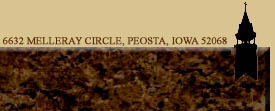|
Mutual Service in Manual Labor |
|
Shared Liturgical Prayer |
|
Meditational Scripture |
|
Prayer in the Heart |
The ultimate goal of the monastic life is identical to the goal of every liturgical prayer. That goal is the fullest possible conscious awareness of God and the most loving attention to God. This is the same thing as contemplation: conscious loving attention to God. Liturgy is an exercise in contemplative life.
A fundamental spiritual asceticism is required of us in order to participate profitably in the liturgy. We must want God and desire union with God in our liturgical prayer. Without this love and desire, liturgy would be empty, valueless formality. Even if we have nothing else to bring than this desire for God, the liturgy will be a royal highway leading us to God's Presence.
The Liturgy of the Divine Office is made up of words, actions, postures and material things. Of all the material constituents of the Divine Office, the pre-eminent one is the church building itself. We have to cultivate a mystical attitude toward the Abbey church. It is the here and now symbol of God's dwelling place. The church is the "burning bush" where God revealed God's Self to Moses. It is a new Mt. Sinai, where God binds God's people to God's Self in a covenant of grace and truth. It is the desert tabernacle in which God accompanies God's people through the wilderness of this life. It is the Temple where God dwells among us and receives our sacrifice of praise.
More than all this, the church is the sacred symbol of the Body of Christ, in whom all the fullness of Deity dwells. We must make holy this sacred place where the hallowed name of God dwells. Before entering the church let us divest ourselves of all temporal preoccupations. Angry, resentful thoughts have no place here. Let us be mindful of God as we go in. Ordinarily, it is appropriate to kneel down as soon as you reach your place in church and say a short fervent prayer for the proper dispositions that your worship may be acceptable to God.
So much for the church. The liturgy that takes place there is made up of postures, movements, speaking and listening. The two principle postures of the liturgy are standing and sitting. Our bodies should express the spiritual reality of the liturgy. When we stand or sit in church, we do so in the presence of God. Our posture ought to be a prayer in itself. "As Yahweh lives before whom I stand...", that was how the ancient prophets spoke. We are their successors. We stand "in the presence of God," as do the angelic hosts. We also rise and stand "before the Son of Man," ready to meet our Lord whenever the Gospel is read.
Sitting, in the liturgy, is the posture of listening, the posture of quiet contemplation and prayer. We sit, like Mary of Bethany, to hear the words of God. Except for the "coming of Christ" in the Gospel, we also sit for the readings at the liturgy. There is a period of silent prayer following each reading. We pause, seated, to reflect prayerfully on the word we have heard.
In all cases, whether standing or sitting, our posture should be worshipful. We should hold our bodies in a dignified graceful manner that befits children of God.
A worshipful attitude is likewise called for in the bodily movements of the liturgy. These movements are principally two: the bow of adoring reverence and turning toward the altar. We should put our heart into it every time we bow over at the doxology. Each Office opens with a doxology and each psalm concludes with one. Let us, at these times, express our adoration by bowing profoundly with a great spirit of worship in our hearts.
The last part of each Office is performed facing the altar. The movement of "turning toward the altar" has a very definite meaning. The altar represents God. In our church, the Blessed Sacrament is reserved behind the altar, so that, turning toward the altar is turning toward Our Lord in the Eucharistic Presence. Turning to God, to Christ, is a symbol of repentance. If there has been any distraction of mind during the liturgy, the action of "turning toward the altar" should be a call to repentance and recollection. We turn our bodies to the altar; we turn our minds to God. In this renewed disposition we are prepared for the Lord's Prayer and other petitions that we pray at each Office "turned toward the altar."
Now about the words of the Liturgy. These words have life-giving power. We ought to strive to be attentive in listening to the words of the readings and prayers we are meant to hear. When singing or reciting we should try to proclaim the words with a heartfelt sincerity and lively interest, whether it be the psalms, the responsories or the Lord's Prayer.
If you try to live the liturgy in the practical ways here suggested, you will be transformed by it. As far as you are able, be alert, aware, conscious and attentive to God in the liturgy. Then more and more, you will experience the reality of the mystery which the liturgy celebrates in signs. More and more, Christ will live in you. Your presence, your actions, your prayers at the liturgy will become the visible earthly expression of Christ' prayer in heavenly glory. You will become God's liturgy.

 An off-site link
An off-site link An e-mail link
An e-mail link